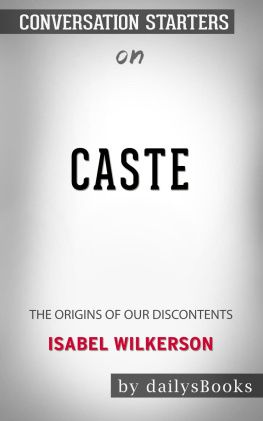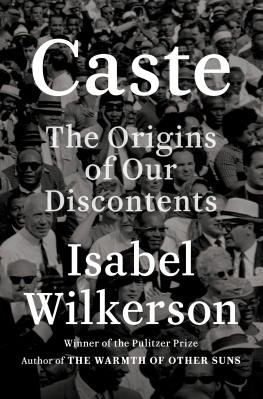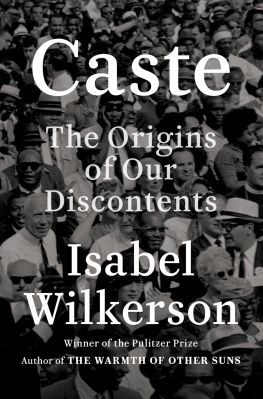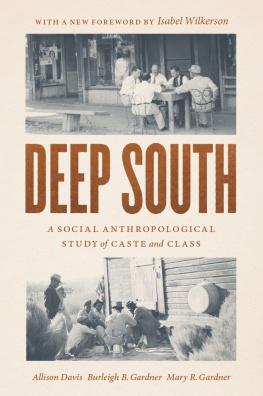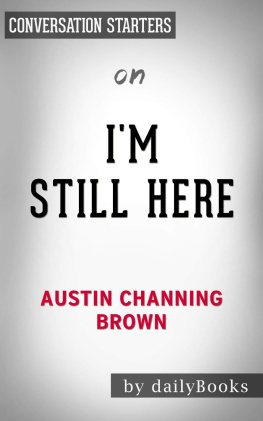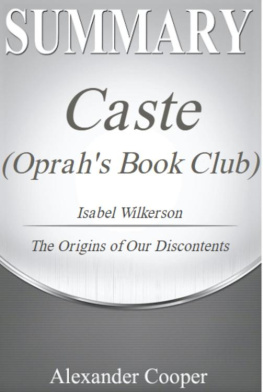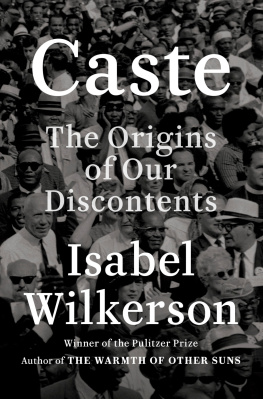Conversation Starters
on
Isabel Wilkersons
Caste
By dailyBooks
About Us:
THROUGH YEARS OF EXPERIENCE AND FIELD EXPERTISE, from newspaper featured book clubs to local library chapters, dailyBooks can bring your book discussion to life. Host your book meets as we discuss some of todays most widely read books.
Copyright 2020 by dailyBooks. All Rights Reserved. Published in the United States of America
Disclaimer: This is an unofficial conversation starters guide. If you have not yet read the original work we encourage you to do so first before reading this Conversation Starters Product names, logos, brands, and other trademarks featured or referred to within this publication are the property of their respective trademark holders and are not affiliated with dailyBooks. The publisher and author make no representations or warranties with respect to the accuracy or completeness of these contents and disclaim all warranties such as warranties of fitness for a particular purpose. This guide is unofficial and unauthorized. It is not authorized, approved, licensed, or endorsed by the original book's author or publisher and any of their licensees or affiliates. No part of this publication may be reproduced or retransmitted, electronic or mechanical, without the written permission of the publisher.
Tips for Using dailyBooks Conversation Starters:
EVERY GOOD BOOK CONTAINS A WORLD FAR DEEPER THAN the surface of its pages. The characters and their world come alive through the words on the pages, yet the characters and its world still live on. Questions herein are designed to bring us beneath the surface of the page and invite us into the world that lives on. These questions can be used to:
- Foster a deeper understanding of the book
- Promote an atmosphere of discussion for groups
- Assist in the study of the book, either individually or corporately
- Explore unseen realms of the book as never seen before
Table of Contents
C aste: The Origins of Our Discontents is the second nonfiction book written by journalist and author Isabel Wilkerson. It focuses on the caste's evolution as the author traces back its historical origin. Wilkersons melding of sociological and historical narratives fortified by her journalistic adeptness yielded a compelling account of the American society built upon inequality and chauvinism. She looks beyond concepts like racism, which she considers to be too narrow, and instead argues that the U.S. social hierarchy is a deeply embedded artificial caste system that deceptively classifies people by virtue of their birth. Wilkerson calls for the creation of a transformative and unique framework through which Americans can understand the level of bias and injustice that has grown rampant and unchecked in the nation.
Wilkerson starts the book similar to that of a dystopian novel. She recounts the great bewilderment that took over the country after the release of the 2016 election results, wherein Donald Trump was elected as the President of the United States. She compares it to a rather strange phenomenon that happened due to climate changethe spread of Anthrax, a fatal infectious disease caused by spore-forming bacteria trapped in the permafrost. Due to the increase in global temperatures, snow in the tundra region started to melt, thereby releasing the bacteria into the atmosphere. Through the parallelism, Wilkerson suggests how old poisons are returning to haunt us. She then recalls how the majority of Americans believed that the election of Barack Obama was a sign that the nation and its political landscape were at the advent of change. The 2016 Presidential Election was especially reflective of the publics hope for a post-racial era. However, she reminds readers of the bitter truth that the majority of the white population did not vote for Obama. Through such examples, she uncovers the illusion of progress orchestrated by politicians to pacify the growing civil rights movements in the country and to maintain their control over the caste.
Avoiding words such as race and racism, Wilkerson instead uses terms such as dominant caste, favored caste, upper caste, and lower caste. To illustrate the systems issues, Wilkerson includes poignant real-life stories of discrimination faced by African Americans in their home country. She shares the anecdote of a Texan girl born to Black parents during the height of the civil rights era. In those days, Black people were addressed only by their first names without any honorary salutations such as Mister or Miss. As an act of subversion, the girls parents named their daughter Miss a brilliant retaliation and mockery of the caste system.
Wilkerson proceeds to examine the caste systems prevalent in other countries, specifically in Nazi Germany and India. The Dalits of India were referred to as the untouchables who were denied fundamental rights such as education and access to the source of drinking water and were considered inferior to the other castes. Indias caste system still persisted despite the promulgation of the Constitution of India, which was primarily authored by a Dalit, Bhimrao Ramji Ambedkar. He devoted his entire life into upholding the rights of the Scheduled Castes in the Indian Constitution.
Wilkerson, a Black woman, shares her own experiences as a prominent journalist. Though it may seem that a person of her stature isnt a likely target of discrimination, she highlights how even educated and successful Black Americans continue to be victims of microaggressions and prejudice. While promoting her book, a boutique manager reached out to her for an interview to which she readily agreed to do. However, upon seeing the author in person, he couldn't believe that she was Black and even asked for an identification card, as the manager had been under the impression that the author was a white woman. She recounts another incident where a white man had tried to sexually assault her while pretending to retrieve his luggage in the first-class section of a plane. The onlookers kept silent and acted as if no one noticed the attack.
The caste inflicts immeasurable harm to those at the lowest rungs of society to this day. Wilkerson argues that the damage caused by such segregation is most glaring in the disparity between the access to healthcare of those in the dominant from the lower caste. She also points out the Whites unwillingness to acknowledge the Blacks achievements and their insensitivity to the suffering of the lower caste, who unknowingly subscribe to the concepts of victimhood and ignominy due to racial disregard. Wilkerson finally details the recent notion of American racism as a collective disease. She explains how the social psychology of group behavior demonstrates the universality of everyday bigotry, which forms the basis of social interaction.
Next page
